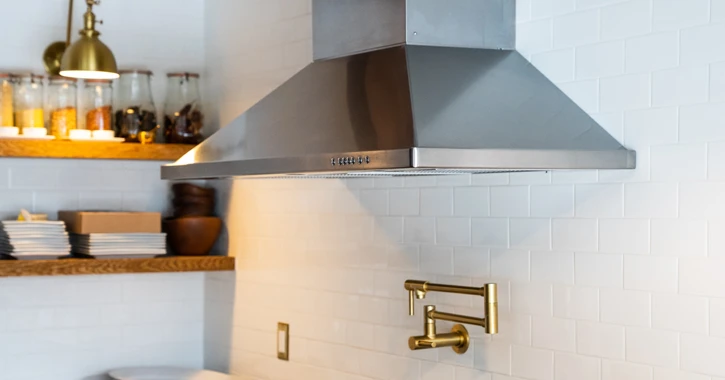
If you love to cook, you need a kitchen exhaust fan. Also known as a hood fan or a range hood, a kitchen exhaust fan is necessary to remove grease, smoke, and fumes that are present in the air when cooking in your oven or on your stovetop.
Before we get into kitchen exhaust fan installation, you must understand the two different types of kitchen exhaust fans and the benefits of each:
Ducted Kitchen Exhaust Fans
A ducted kitchen exhaust fan draws air from your kitchen through a duct and releases it outside. Because this type of exhaust fan requires ductwork and piping running from your kitchen to the outside of your home, it can have limited location options.
Since they release the captured air outside as opposed to just recycling or filtering it, ducted exhaust fans remove moisture caused by humidity and steam from cooking, unlike their ductless counterparts.
Ducted fans need careful installation, which could be left to the experts, or done yourself, depending on your experience level.
Ductless Kitchen Exhaust Fans
Instead of filtering air outside the home, a ductless exhaust fan draws kitchen air through a carbon or charcoal filter that cleans the air of odours and smoke particles and cycles it back out into your kitchen. Ductless fans are a little bit more versatile since they can be installed just about anywhere.
Ductless exhaust fan filters need to be cleaned or replaced annually. The drawback to the ductless fan is that it does not remove moisture, so your kitchen can still become quite humid. They also require more power than a ductless fan, which can make them a bit noisier.
How to Install an Exhaust Fan in Your Kitchen
Ready? Here we go.
How to Install a Ductless Exhaust Fan
A ductless range fan is relatively easy to install since it does not require ductwork or piping. It does need its own electrical outlet, though, so if that is not already present you will have to have an electrician install one. After that is completed, follow these steps:
- Find the centre point of your wall above your cooking range.
- Check your measurements on your new range hood and make sure you will have the needed space for installation.
- Follow the installation instructions on your new hood fan. You’ll need to use a stud finder so that you can anchor the hood fan to the studs.
How to Install a Ducted Exhaust Fan
Installing a ducted range hood is a little bit more involved. We highly recommend speaking to an expert at Aire Serv before installing the ductwork yourself. If you’ve already done so, follow these steps:
- Measure the length of the pipe you’ll need to extend through your wall to the outside.
- Check the instructions on your new hood fan to see if you’ll need to extend the piping above the range hood or if it will go directly behind it.
- Measure 24 to 30 inches above your kitchen range for the placement of the hood range fan. Using the template that came with your fan, cut into the drywall using a saw or drill.
- Using your pipe as an outline, cut out a vent in your outside wall.
- Caulk the vent cap and place it on the exterior wall.
- After turning off the electricity, mount your new range hood. Use the included instructions as a guide.
- Connect the necessary pipes with aluminium duct tape.
- Turn the electricity back on and test your new exhaust fan.
If you’re feeling overwhelmed by all this information and all the available kitchen exhaust fan options, contact Aire Serv today. A trained tech will go over all your options and help you choose the right one for your home. Schedule an appointment online today.

